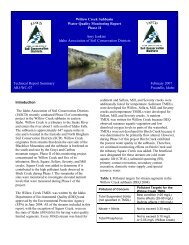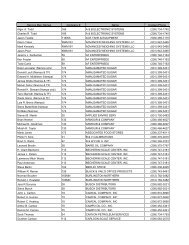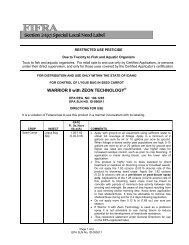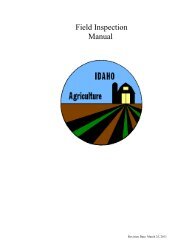2008 Statewide Strategic Plan for Eurasian Watermilfoil in Idaho
2008 Statewide Strategic Plan for Eurasian Watermilfoil in Idaho
2008 Statewide Strategic Plan for Eurasian Watermilfoil in Idaho
Create successful ePaper yourself
Turn your PDF publications into a flip-book with our unique Google optimized e-Paper software.
and provides assistance to cooperators with the implementation of these<br />
protocols.<br />
The goals and objectives of this survey program are as follows:<br />
1. To identify and del<strong>in</strong>eate populations of <strong>Eurasian</strong> watermilfoil <strong>in</strong> water<br />
bodies receiv<strong>in</strong>g state fund<strong>in</strong>g <strong>for</strong> treatments.<br />
2. To quantify the distribution and frequency of <strong>Eurasian</strong> watermilfoil<br />
populations be<strong>for</strong>e and after control treatments to gauge treatment efficacy.<br />
3. To quantify the distribution and frequency of all aquatic vegetation on a<br />
water body-wide scale.<br />
4. To identify new populations of <strong>in</strong>vasive aquatic and emergent plants.<br />
5. To identify new populations of other aquatic nuisance species (ANS).<br />
1. Littoral Survey<br />
In order to identify <strong>Eurasian</strong> watermilfoil<br />
and other exotic plant populations, a<br />
survey of the lake’s littoral area is<br />
conducted. The littoral zone is def<strong>in</strong>ed as<br />
the shallow area near the shore of a body<br />
of water that extends from the shorel<strong>in</strong>e<br />
lakeward to the limit of occupancy of<br />
rooted plants. This survey may be<br />
conducted from a boat us<strong>in</strong>g rake throws<br />
and/or underwater viewers, by<br />
snorkel<strong>in</strong>g, or by SCUBA divers (Figure<br />
11). The littoral zone is surveyed by<br />
navigat<strong>in</strong>g <strong>in</strong> a regular pattern. If<br />
survey<strong>in</strong>g from a boat, regular rake<br />
Figure 11. Scuba div<strong>in</strong>g <strong>for</strong> <strong>Eurasian</strong><br />
watermilfoil<br />
throws are used to check <strong>for</strong> <strong>Eurasian</strong> watermilfoil <strong>in</strong> areas with limited visibility.<br />
As water clarity decreases, rake sampl<strong>in</strong>g <strong>in</strong>creases. When <strong>Eurasian</strong> watermilfoil<br />
or other aquatic nuisance species are found, the location is recoded, the area is<br />
outl<strong>in</strong>ed with a GPS, and an estimate the percent <strong>Eurasian</strong> watermilfoil cover is<br />
recorded. Cover estimates are recorded as dense, sparse or no <strong>Eurasian</strong><br />
watermilfoil cover.<br />
The location of <strong>in</strong>vasive emergent shorel<strong>in</strong>e plants are also recoded as they are<br />
detected (purple loosestrife, garden loosestrife, phragmites, yellow iris, tamarisk,<br />
Russian olive, etc.). Littoral surveys are conducted by agencies, universities,<br />
groups or <strong>in</strong>dividuals that are not affiliated with the contractor apply<strong>in</strong>g control<br />
treatments. Contractors may, however, provide aerial images to assist <strong>in</strong> the<br />
littoral survey. If the system has some k<strong>in</strong>d of stage measur<strong>in</strong>g device<br />
(downstream dam, stage gage) a stage read<strong>in</strong>g should be <strong>in</strong>cluded <strong>in</strong> the survey<br />
data set.<br />
22
















